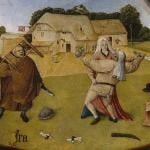It’s the Eve of St. Agnes, and it’s cold. Cold as the beginning of Keats’ long lyric poem, set on and named for this night:
St. Agnes’ Eve — Ah, bitter chill it was!
The owl, for all his feathers, was a-cold;
The hare limp’d trembling through the frozen grass,
And silent was the flock in the wooly fold . . .
If you were a young unmarried European woman on this night, in times past, you’d be preparing yourself like Keats’ heroine Madeline to receive a rapturous vision of your husband-to-be. The ritual involved fasting from dinner, undressing, and lying naked on your back in bed with your hands tucked under the pillow, never allowing your eyes to stray around behind the bed. Fall asleep in that position–if you could, in the cold–and you’d be guaranteed a dreamy visitation, complete with ghostly kiss, from the spouse picked out for you by the patron saint of virgins, who earned that title by rejecting all the spouses picked out for her.
If you are a couple of lambs in the “flock in the woolly fold” of the Trappist monks of Tre Fontane in Rome tonight, you are looking forward in your woolly way to tomorrow morning, when, crowned with roses, you will be placed in a beribboned basket and carried to the Church of Sant’Agnese fuori le Mura (St Agnes Outside the Wall) in Rome. Escorted by veiled young girls in white dresses and guarded by Rome’s elite and stylish military police, the carabiniere, you will be led to the altar, where you will be incensed and sprinkled with holy water. Your journey will continue to the Vatican, where you will be blessed by the Holy Father himself (this is what it looked like for last year’s lambs) and entrusted, in a kind of passing of the religious baton, to the Benedictine nuns of the Convent of Santa Cecilia in Trastevere, Rome’s old Jewish quarter. The good sisters will fatten and groom and spoil you, and on Holy Thursday they’ll shear your wool and turn it over–grab that baton!–to the Oblates of St Frances of Rome, who will weave it into the white wool band embroidered with crosses known as the pallium.
The Oblates will weave as many pallia as there are new metropolitan archbishops in the world since last June. On the 28th of June, the pallia will spend the night in the Confessio, the shrine containing the altar built over the tomb of St Peter in the Basilica that bears his name. The next morning, on the Feast of St Peter and St Paul, the pope will present the blessed pallia to the new archbishops as a sign of their authority and a yoke of their service. But you, little lambs, emblems of the patron saint of chastity (because your name in Latin, agnus, is so similar to hers, Agnes, from the Greek for pure and chaste) will not be there to see your wool go out into the world, for you will long since have served as Easter dinner for the nuns at St Cecilia’s.
Girls in love and lambs to the slaughter. They’re both bound up in the legenda, the exemplary life, of St Agnes, whose feast the Church celebrates on January 21. By tradition, Agnes was a third-century Roman tween–about 12–of noble Christian background who angered an official by refusing to marry his son, on the grounds that she was in love with Someone else. She also announced that she’d be refusing any other offers of marriage, thank you very much, and was not going to be doing any of that sacrificing to idols thing, either. This early-Church equivalent of putting on a purity ring cost Agnes everything. The frustrated official avenged his family pride by having Agnes condemned to death as a traitor to the Empire and its gods. The Romans were squeamish about executing virgins, so the story goes, but not above dragging Agnes naked through the streets to imprisonment in a brothel, where the impediment to execution would presumably be removed pretty quickly.
Under divine protection, however, Agnes’ virtue was preserved through all attempts to separate her from it. The efforts were many, and–as with rape and child prostitution and human trafficking in any age–horrific, but (as doesn’t happen nearly as often as it should) the attempted rapists were rebuffed and struck blind. In a prison vision of grace as welcome as a St Agnes Eve visit from a dream lover, Agnes’ hair grew to cover her nakedness, and an angel of God wrapped her in a robe of purest white lambs’ wool. Agnes’ invincible chastity having become apparent, the no-virgin-killing law was waived. The officials tried burning her, but the flames ran away from her body. Finally, she was either beheaded with a sword or had her throat cut with a dagger.
United after death with her heavenly Bridegroom, Agnes is apparently like every girl happy in love–she wants to fix her friends up, too. So she’ll send you a soulmate if you’re serious about asking. At least, that’s how the story goes. Me, I’m out here in the cold with the lambs, wondering in my own woolly way why it is with us humans–even among the best of us, even in love, even in an incense-clouded church–that what begins in innocence so often ends in blood.
UPDATE: Here, courtesy of Deacon Greg Kandra, is this year’s lamb blessing.
















